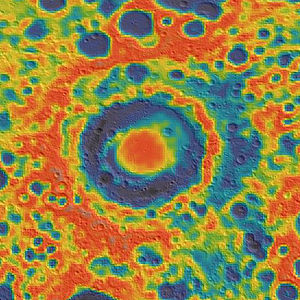Mare Moscoviense
Coordinates 27°18′N 147°54′E / 27.3°N 147.9°E | | |
| Diameter | 276 km[1] | |
|---|---|---|
| Eponym | Sea of Muscovy | |
Mare Moscoviense (
The great depth of this mare beneath the nearby highlands probably explains why mare units are so rare on the lunar farside. Very few basins on the farside were deep enough to allow mare volcanism. Thus, while large impact basins are found on both the nearside and farside, large maria are mostly found on the nearside. Mare lavas apparently could reach the surface more often and more easily there. The basin material is of the
At the center of the basin (or the southwest portion of the mare) is a mascon, or gravitational high. The mascon was first identified by Doppler tracking of the Lunar Prospector spacecraft.[5]
The crater Titov is in the northeastern region of the mare, and Tereshkova lies along the northern edge. The floor-fractured crater Komarov lies on the southeast edge of the mare. The Korolev basin is to the southeast of the mare, and the Freundlich-Sharonov Basin is to the east.
According to
Gallery
-
Composite image of the far side of the Moon. Mare Moscoviense is visible in the upper left quadrant.
-
Topographic map
-
Gravity map based onGRAIL
-
Mare Moscoviense from Lunar Orbiter 5, clearly showing the extent of the basin in which the mare lies.
-
Mare Moscoviense from Apollo 13
-
Oblique view from Apollo 16, with the mare at the horizon. The outer basin rings are subtle but visible in this view.
See also
- Leonov (crater), named for cosmonaut Alexei Leonov, lies just to the south of Mare Moscoviense
References
- ^ "Mare Moscoviense". Gazetteer of Planetary Nomenclature. USGS Astrogeology Research Program.
- USGS Professional Paper 1348. By Don E. Wilhelms, John F. McCauley, and Newell J. Trask. U.S. Government Printing Office, Washington: 1987. Table 9-3.
- ^ Zamora, A. (2013), Mare Moscoviense – A Meteorite Cluster Impact on the Moon, ScientificPsychic.com, [2], accessed 2022-01-08
- PMID 9727968.
- ^ "Lunar Exploration Timeline – Lunar Missions – 1959 – Luna 3 (Oct 4, 1959 – Probe)". NASA. Retrieved 14 December 2020.
- ^ "XIth General Assembly" (PDF) (in French and English). International Astronomical Union. 1961. Retrieved 26 July 2015.
- PMID 22914129.
External links
- The mare is seen shortly after the 1:20 minute mark in this NASA video commemorating Apollo 13






